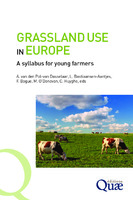Grassland use in Europe
Contributor(s)
van den Pol-van Dasselaar , Agnes (editor)
Bastiaansen-Aantjes , Leanne (editor)
Bogue , Fergus (editor)
O’Donovan , Michael (editor)
Huyghe , Christian (editor)
Language
EnglishAbstract
"Covering 40% of the European agricultural area, grasslands are vitally important both for agriculture and society. These grasslands serve multiple functions, including the local provision of fodder for animal husbandry (and hence high-quality food provision for people), biodiversity conservation, carbon storage and the provision of ‘traditional’ landscapes that European citizens appreciate for recreational purposes and cultural heritage.
The future of grassland farming in Europe is in the hands of young farmers. Compared to other topics, grassland management has often been a weak point of teaching delivered by agricultural technical schools in several European countries. The training of future farmers and advisors could thus be significantly improved, which could lead to better grassland management in the medium and long terms. For this reason, the European project Inno4Grass created a syllabus and a set of PowerPoint presentations on practical grassland management for current and future generations of grassland farmers and advisors."
Keywords
biodiversity; cattle; water; environment; Europe; milk; meadow; vegetable productionDOI
10.35690/978-2-7592-3146-1ISBN
9782759231478; 9782759231454Publisher
éditions QuaePublication date and place
2019Classification
Animal husbandry


 Download
Download